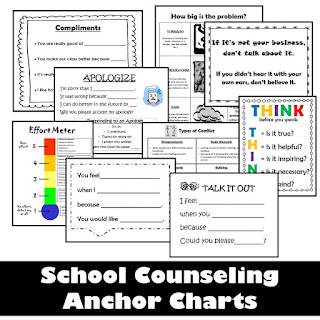While the bulk of 4th grade's Life Skills curriculum this year is on positive communication, there's a personal identity/awareness component as well. We kicked off 2017 with a lesson about personal values (with some mention of reputation thrown in). Due to a few scheduling issues, I ended up doing this lesson
before the
"Staying True to Yourself" (with Ludwig's
Sorry!) lesson in some of the classes and
after in some others. Both ways were great for tying the lessons together; I haven't decide which way I'll do it next year.
A good friend of mine who is a middle school counselor sent me the link to this lesson that she adapts and uses:
Overcoming Obstacles - Clarifying ValuesI adapted it even further (to shorten it and to make it more elementary level) and began using it myself. It's fun, it's silly, it's interactive, and it gets their brains going. I'll admit that while the majority of my lessons are skills-based, this one is more "planting the seed" and helping develop some introspection as they prepare to enter the intense and challenging world of middle school.
I use a PPT to facilitate the first half of the lesson. We start with a quick game of "Would you rather?" - the students either move to the side of the room that goes with their answer or they use arm motions (which in one room resulted in us all "dabbing"!). I explain how their answers are the result of some of their personal values...and then I explain what personal values are and give some examples.
The last slide in the PPT gives them an example of how to complete their "personal values table". It's essentially a worksheet where they list 16 of their personal values using different categories to guide them. After they've all finished filling theirs in, I ask them to cut them all out and group them by category on their desk/table.
Then the real fun begins! I explain that just like in "Would you rather?", in real life, we sometimes have to choose between values and decide what's more important to us. In the activity we do next, I ask the students to literally throw away some of their values; they do much better if I prep them ahead of time and let them know that's coming. Then I read aloud a silly story about them going on a wild and crazy trip to the zoo, with lots of shenanigans and dilemmas, that ends with them having their top three personal values left.
Then together we process and I ask them: o How did you feel about the decisions you made? Why?
o Which were the hardest ones for you to make?
o If you were to play this game again, would you choose to have different squares at the end? Raise your hand if you would. Write on the back of the squares the values you wish you'd kept.
 *This is a pretty accurate depiction of what most of them were left with!
*This is a pretty accurate depiction of what most of them were left with!























